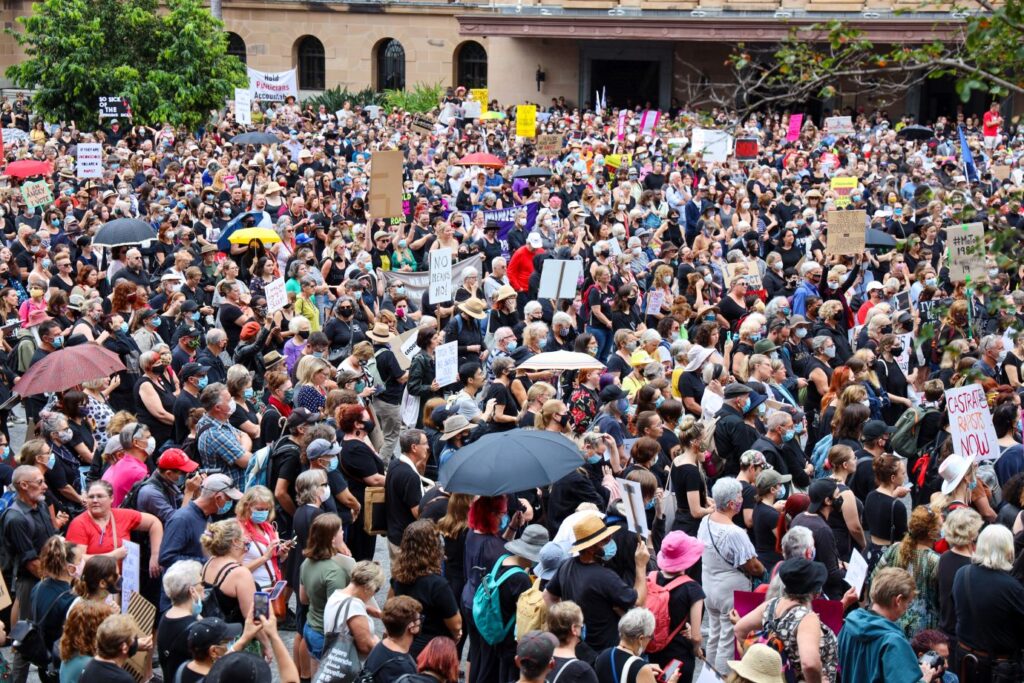In the introduction to the 1994 edition of Damned Whores and God’s Police, Dr Anne Summers, leading feminist author and activist, reflected on her time in the United States. She observed a women’s movement that had lost its teeth:
“I was amazed at the seeming impotence of the women’s movement, their inability to influence or even be part of the campaign debate… Ultimately I became convinced that at least part of the responsibility for the movement’s political frailty lies with the movement itself, especially the national leadership, which has no political strategy whatsoever.”
It’s a scathing assessment. And one that resonates a little too much when I think about Australia today.
At Sydney Writers’ Festival this year, Summers contrasted that frailty with today’s young women in Australia. According to her, this generation has the same energy as the movement she helped shape in the ’70s.
But there’s a risk of that energy becoming static. As the delirium of the federal election circus subsides, it’s time to assess our efforts to stop gendered violence. It barely rated a mention during the election campaign. And whenever the issue has surfaced over the past year, the platitudes have worn thin: No one government can solve this, fund the National Plan, it’s everyone’s responsibility. At times, I’ve half-expected them to break out into High School Musical: ‘We’re all in this together!’
But are we, really?
It’s not for lack of incredible survivor-advocates or organisations. Australia has a wealth of vital changemakers. But much of this work happens in fragmented silos, with groups competing for limited funding and working under different frameworks. How much more powerful could this movement be if those doing this work joined forces?
At a recent event, Jess Hill, journalist and author of See What You Made Me Do, spoke about her Quarterly Essay, Losing It: Can We Stop Violence Against Women and Children? Hill was part of a Rapid Review of Prevention Approaches expert panel last year. They made 21 recommendations, including prioritising First Nations women and focusing on children and young people. Hesitantly, I asked if she’d seen any real sign of political will to act on them. Her response point to some positives, such as Albanese’s negotiations with National Cabinet on alcohol reform — but also warned of powerful lobbies like ClubsNSW.
“There is some will,” Hill reassured. “It’s just scattered.”
And there it is. We can blame governments, or ask whether that scattered political will is reflecting scattered advocacy.
As we watch the shattered Coalition try to put Humpty Dumpty back together again, it might seem like satire to suggest a feminist coalition. But it might be exactly what’s needed.
Hill’s essay, along with her report Rethinking Primary Prevention with Professor Michael Salter, has necessarily highlighted some schisms in our approaches, and underscored the need for a return to pragmatism. “There’s no need for this to be divisive,” she told the ABC. “The essay is actually calling for genuine unity — for violence prevention strategies to bring back other evidence-based approaches that have been sidelined.”
There will always be nuanced opinions about how to get there, but the common goal remains the same: stop violence and oppression. As bell hooks simply defines, feminism is “a movement to end sexism, sexist exploitation, and oppression.”
The problem isn’t disagreement — it’s the absence of a dedicated, independent space to discuss and coordinate, away from public politicking, funding dependencies, and bad-faith media reporting. What’s missing is a national, cross-sector forum to provide a non-public space where issues like coercive control legislation and prevention strategies can be worked through safely, and where a joint advocacy platform can be built on what’s agreed.
We’ve seen what coordinated feminist action can achieve. The suffrage movement won the vote for most women in 1902, though for Aboriginal women, this shamefully came far later. In the following decades, the National Council of Women of Australia became a key national voice for women’s education, legal rights, and social welfare. They maintained a direct line to the Prime Minister. Later, the Women’s Electoral Lobby (WEL), founded in 1972, became the most effective feminist lobby group of its era. It forced political candidates to answer directly on women’s issues, and drove reforms on equal pay, abortion, and childcare.
While both organisations still exist and do important work, no national and independent platform today holds the unifying influence that once made feminist reform politically unavoidable. Organisations like Our Watch and other peak bodies play a vital role, but their ability to criticise government is inevitably limited by their funding. Grassroots, survivor-led movements like ‘What Were You Wearing?’ have also done extraordinary work in mobilising communities. But without a national, coordinated advocacy platform to turn that momentum into lasting reform, moments risk becoming just that: moments.
Brittany Higgins recently noted that while #MeToo sparked vital reforms, pushback is strong; she argues, “the only way forward is through open, honest, and uncomfortable conversation.”
With a resounding Labor victory and a record number of women in parliament, we have a rare window. Anne Summers has long argued the importance of pragmatism in advocacy: not just opposing governments, but building the kind of political strategy capable of influencing them. That’s no less true now. If we don’t organise, we risk wasting the best opportunity we’ve had in years.
Become a Women’s Agenda Foundation member and support our work! We are 100% independent and women-owned. Every day, we cover the news from a women’s perspective, advocating for women’s safety, economic security, health and opportunities. Foundation memberships are currently just $5 a month.
Bonus: you’ll receive our weekly editor’s wrap of the key stories to know every Saturday.


